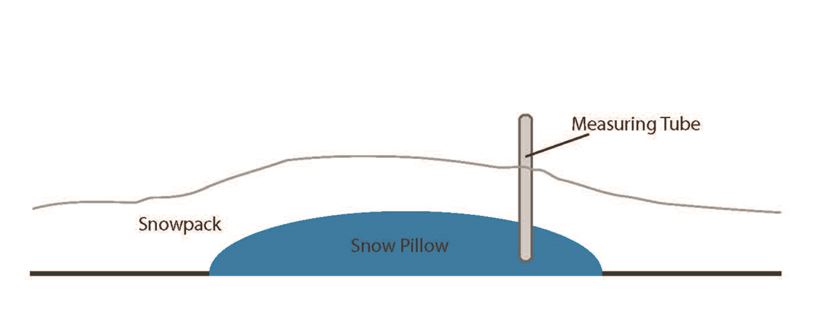Snow is a part of the hydrologic cycle; it is frozen water. Snowpack is the snow that falls onto the ground and does not melt until temperatures warm up in the spring. Snowpack can be found anywhere that is cold enough for snow. For example, there can be a large amount of snowpack accumulating over the course of the winter in the mountains (Figure 1).
Snow depth is measured regularly by various organizations throughout the province, including Alberta Environment and Sustainable Resource Development (ESRD). There are special tools used to measure snowpack called snow pillows, which measure the weight of the snow and tell you how much water there would be if the snow were to melt. Once the temperature warms up in the spring, the snowpack begins to melt. The snow that melts into water is called snowmelt. This snowmelt plays an important part in the hydrologic cycle, and is a key source of water for streams. In extreme circumstances, rapid snowmelt, along with intense rainfall, can be a factor in flooding.
![Figure 1. Snowpack in the mountains. Snow accumulates on mountains throughout the winter. This stored water is referred to as snowpack [1].](https://waterportal.ca/wp-content/uploads/2015/03/Snowpack-in-the-mountains.jpg)
Snowpack can be found anywhere that air temperatures are below freezing. In Alberta, snowpack can be found across the province from the prairies to the mountains. The mountains typically have much deeper snowpack than the prairies. Open areas in the mountains accumulate much more snow than forested areas because there are no trees to intercept the snowfall. However snow melts slower under a forest canopy because the tree cover shades the snowpack from the sun. Snowpack can accumulate for the entire winter, reaching depths over one metre in some regions in Alberta.
In Alberta, Alberta Environment and Sustainable Resource Development’s (ESRD) River Forecast Centre (RFC) monitors the snowpack. The RFC performs manual surveys once or twice a month where field crews measure the depth and density of the snow. ESRD also has data collection tools in the mountains that measure snowpack, including snow depth sensors and automated snow pillows (ASPs). The RFC also uses snow data from Environment Canada and the United States’ National Oceanic and Atmospheric Administration (NOAA) [2].
Amateur meteorologists can also collect snow data. The Community Collaborative Rain, Hail and Snow Network (CoCoRaHS) is a community-based group of individual volunteers who measure and report precipitation levels in their respective jurisdictions.
A snow depth sensor is an automated instrument that measures snow depth. Snow depth sensors measure snow depth using sound waves. These data are collected and transmitted to the RFC continuously over the winter via satellite.
An automated snow pillow (ASP) is a large bladder filled with anti-freeze (Figure 2). When snow gathers on top of the pillow, the snow pushes down on the bladder and sends the antifreeze into a measuring tube that sticks up above the snow. Forecasters use these data along with their manual surveys to understand how much snowpack there is at a given time [3].

The CoCoRaHS program began in Colorado in 1998. The organization provides citizen scientists with a rain gauge that is used for measuring rain, hail and snow. Volunteers collect data and submit it to CoCoRaHS. Since its inception, the program has spread across the U.S. and Canada. In some jurisdictions, flood forecasters use the CoCoRaHS data to fill any data gaps. To learn more about CoCoRaHS or to sign up for a rain gauge go to http://www.cocorahs.org/Canada.aspx.
[1] “Upper Kananaskis lake Alberta Canada December 2014” by davebloggs007 is licenced under CC BY 2.0.
[2] Alberta WaterSMART and Alberta Innovates – Energy and Environment Solutions .(2014). Flood Forecasting Jurisdictional Review: Improving Flood Forecasting in Alberta. Retrieved from: http://albertawater.com/flood-forecasting-jurisdictional-review/file
[3] River Forecast Centre .(2014). What Is An Automatic Snow Pillow (ASP) Station? BC Ministry of Forests, Lands and Natural Resource Operations. Retrieved from: http://bcrfc.env.gov.bc.ca/about/snow-pillow.htm
We provide Canadian educational resources on water practices to promote conservation and sustainability. Our team crafts current and relevant content, while encouraging feedback and engagement.
The Canada WaterPortal is a registered charity, #807121876RR0001
We recognize and respect the sovereignty of the Indigenous Peoples and communities on whose land our work takes place.
© 2025 All Rights Reserved.